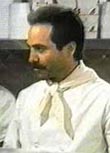|
|
This topic comprises 2 pages: 1 2
|
|
Author
|
Topic: Scratch Problems
|
|
|
|
|
|
|
|
|
|
|
|
|
|
|
|
|
|
|
|
|
|
|
|
|
Dave Callaghan
Film Handler
Posts: 60
From: Toronto, Ontario, Canada
Registered: Jan 2003
|
 posted 02-24-2003 04:02 AM
posted 02-24-2003 04:02 AM




1) Another thing you need to check on pad roller clearance on a Simplex is the adjustment of an eccentric shaft pad roller. The 2 roller pad roller arms have an arm adjustment screw that sets clearance for the roller on the end of the arm. The other roller can be on an eccentric shaft - if you loosen the shaft screw, you can turn the shaft, and if it is eccentric, the roller will move towards and away from the sprocket. If things are really off, you may have to set the eccentric, then reset the arm adjustment again.
2) Thin black scratches sound like base side scratches, but it is worth verifying whether they are just on the base side or also on the emulsion side. Scratches could be happening at more than one place in the film path.
To determine if the projector head or sound head is the source, you can run a loop for 5 minutes then check base and emulsion for scratches. If a pad roller is scratching, bear in mind that if you see a scratch on the right side of the screen, you are probably also picking up a scratch on the opposite side in the sound track area that of course you won't be seeing on screen.
If the projector head and/or sound head turn out to be the source, the projector head pad rollers are on the base side. The pad rollers in a 5 Star sound head are also on the base side.
If you have a sound head with a gear box / constant speed and hold back sprockets, the constant speed pad roller is on the base side. The hold back pad rollers are on the emulsion side.
| IP: Logged
|
|
|
|
Carl Martin
Phenomenal Film Handler
Posts: 1424
From: Oakland, CA, USA
Registered: Feb 2002
|
 posted 12-28-2004 06:51 AM
posted 12-28-2004 06:51 AM





we've been plagued recently with scratches like these on 2 screens. there have been lots of red herrings but i think i've narrowed it to the pad rollers on the upper feed sprocket (century jj & msa). they both have flat spots which cause them to sometimes turn, and sometimes hang up in one position. a tech will be coming in to look at/replace these.
now, i've seen here and heard from others that these pad rollers should not be turning while film is running (except possibly for splices), as the film isn't in contact with the roller. but the pad rollers close onto the sprocket at about the place where the film separates from it to form the upper loop, and it appears that, for at least part of the cycle of the loop, film does contact the roller. how else could a flat spot have developed?
the pad rollers do clear by 2 film thicknesses or more. our upper loops certainly are not too small; any bigger and that jj loop really starts to flap around--though, come to think of it, maybe i should verify that there isn't somebody making the loops too small.
anyways, any further thoughts on this are welcome.
carl
| IP: Logged
|
|
|
|
All times are Central (GMT -6:00)
|
This topic comprises 2 pages: 1 2
|
Powered by Infopop Corporation
UBB.classicTM
6.3.1.2
The Film-Tech Forums are designed for various members related to the cinema industry to express their opinions, viewpoints and testimonials on various products, services and events based upon speculation, personal knowledge and factual information through use, therefore all views represented here allow no liability upon the publishers of this web site and the owners of said views assume no liability for any ill will resulting from these postings. The posts made here are for educational as well as entertainment purposes and as such anyone viewing this portion of the website must accept these views as statements of the author of that opinion
and agrees to release the authors from any and all liability.
|

 Home
Home
 Products
Products
 Store
Store
 Forum
Forum
 Warehouse
Warehouse
 Contact Us
Contact Us




 Printer-friendly view of this topic
Printer-friendly view of this topic














